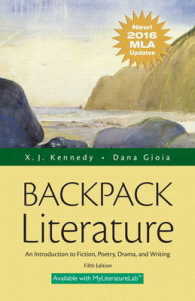Full Description
Synthesizing the theory behind and methodology for conducting judgment tests, Using Judgments in Second Language Acquisition Research aims to clarify the issues surrounding this method and to provide best practices in its use. The text is grounded on a balanced and comprehensive background of the usage of judgment data in the past up through its present-day applications. SLA researchers and graduate students will find useful a chapter serving as a "how-to" guide for a variety of situations to conduct research using judgments, including ways to optimize task design and examples from successful studies. Lucid and practical, Using Judgments in Second Language Acquisition Research offers guidance on a method widely used by SLA researchers, both old and new to the field.
Contents
Table of Contents
Preface
Acknowledgments
Chapter 1: Judgment Data in Linguistic Research
1. Introduction
2. Judgment Data in Linguistics
3. Conclusion
Chapter 2: Judgment Data in L2 Research: Historical and Theoretical Perspectives
1. Introduction
2. Judgment Data in Second Language Research
3. L2 Judgment Data: A Brief History
4. What Knowledge is Being Measured?
5. What are Judgment Tasks Used for?
6. Intervening Variables
7. Conclusion
Chapter 3: Uses of Judgments in L2 Research
Introduction
Frameworks
3. Knowledge Types
4. Specific Constructs
5. Additional Research Areas
6. What languages Have Been Used?
7. Proficiency Levels
8.. Conclusion
Chapter 4: A Guide to Using Judgment Tasks in L2 Research
1. Introduction
2. Design Features
3. Other Considerations
4. Data Sharing
5. Conclusion
Chapter 5: Variations on Judgment Tasks
Introduction
Interpretation Tasks
3. Pragmatic Tasks
4. Preference Tasks
5. Error Correction Tasks
6. Multiple-Choice Tasks
7. Judgment Tasks in Combination With Psycholinguistic and Neurolinguistic Measures
8. Many Task Types in One
9. Conclusion
Chapter 6: Analyzing Judgment Data
Introduction
Cleaning the Data
3. Scoring Responses to Binary and Scalar Judgments
4. Scoring Corrections
5. Basic Inferential Statistics With Judgment Data
6. Reporting Individual Results
7. Rasch Analysis
8. Analyzing Likert Scale Data: z-Scores
9. Binary Judgments: d-Prime Scores
10. Analyzing Magnitude Estimation Scores
11. Using Response Time Data
12. Using Judgment Data Results in Conjunction With Other Measures
13. Conclusion








